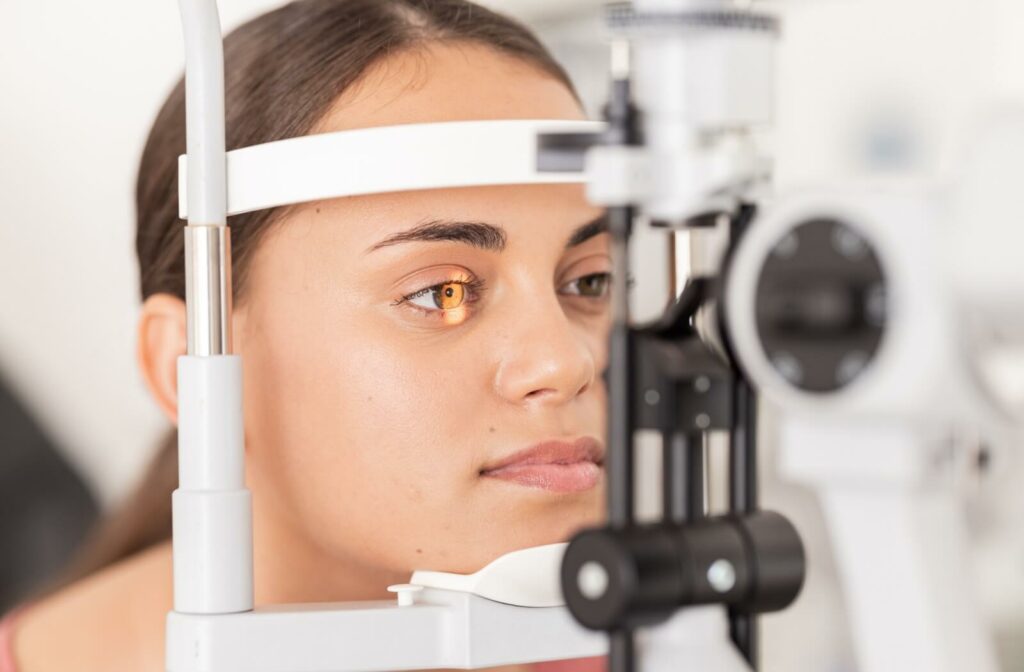We live in a digital world; it seems almost impossible to be more than a few feet from a digital screen at any point. But while these devices have revolutionized the way we work, play, and relax, they can have a long-term impact on your eye health.
When you start to notice heavy feelings in the eyes, blurry vision, headaches, and discomfort, you’re probably dealing with digital eye strain. So how can you protect your eyes?
There are a few steps you can take to protect your eyes from computer screens:
- Optimize your environment
- Follow the 20-20-20 rule
- Avoid screens before bed
- Schedule regular eye exams
Are Screens Dangerous?
Screens themselves aren’t inherently dangerous—at least, they can’t cause damage by themselves. However, they are still responsible for all kinds of problems in the human body.
When we focus on a screen, we tend to blink less frequently—almost 60-70% less. Blinking is responsible for evenly spreading a thin film of tears across your eyes, helping protect them from foreign contaminants, particles, and bacteria. So when you blink less, your eyes easily become dry and inflamed, leading to irritation.
When you’re looking at a screen, you’re also focusing intently on something at a set distance from your eyes. The tiny muscles you use to focus can start to tire out—imagine holding a weight steady for minutes, or even hours, on end. This can quickly lead to tiredness, soreness, and more.
Your posture plays an important role as well. If you find yourself slouching or sitting at odd angles to focus, you’re putting extra strain on your shoulders, neck, and back. When you start to notice these feelings of discomfort throughout your body, it’s digital eye strain.
The Signs of Digital Eye Strain
Digital eye strain develops when you spend too long using screens. Whether a cell phone, tablet, laptop, or desktop computer, your eyes can only handle so much before they need a break. They start to send signals that they’re overworked and tired.
The common signs of digital eye strain include:
- Feelings of soreness, tiredness, or heaviness
- Blurred or double vision
- Headaches
- Neck and shoulder pain
- Sensitivity to light
- Difficulty focusing
If you notice these symptoms when you spend too much time using screens, you’re probably dealing with eye strain.
Tips for Preventing Digital Eye Strain
So how do you prevent digital eye strain and protect your eyes from computers? Whether you’re working, enjoying a game, reading, or any other activity, it’s crucial to practice good habits when at your desk. Try to use the following strategies:
Optimize Your Environment
Your first step should be to optimize your environment. This can go a long way toward preventing digital eye strain—by making the area more comfortable, you make it much easier for your eyes to focus.
Try to:
- Position your screen at arm’s length and slightly below eye level
- Minimize glare on your screen by adjusting lighting or using an anti-glare filter
- Keep your screen clean to reduce eye strain
- Adjust your screen’s brightness and contrast to a comfortable level
- Use a comfortable chair with lumbar support
This way, your eyes can easily do what they need to.
Follow The 20-20-20 Rule
Sometimes, your eyes need a break. It’s completely natural; they can only work so hard for so long before they’re tired. Taking regular breaks is crucial, and it’s often easier than you think.
Try to follow the 20-20-20 rule. This is a simple, yet effective, way to give your eyes a break when you’re using screens. Every 20 minutes, look at an object 20 feet away for at least 20 seconds. This helps your eyes adjust, giving the muscles a break from focusing intently at a set distance. They can relax, helping reduce the risk of developing eye strain.
Avoid Screens Before Bed
Digital devices emit a certain wavelength called “blue light.” This wavelength is closely linked to your circadian rhythm—when you’re exposed to blue light, your body begins suppressing melatonin, the chemical that helps you sleep.
So when you’re using digital devices—particularly later in the day—you’re actually affecting your body’s natural sleep-wake cycle. By avoiding screens, computers, and devices before bed, you can promote better sleep, keeping your eyes and body healthier. If you do need to use anything digital, try to use blue light filters—like night mode or eye comfort shields—to reduce the amount of blue light exposure.
Schedule Regular Eye Exams
Sometimes, the easiest solution is to seek professional help. A quick visit to your optometrist gives an eye care professional a chance to thoroughly examine your eyes. This way, they can see whether or not you have an underlying condition causing your symptoms. They can also give you personalized up-to-date information on preventing eye strain, letting you use your devices in peace and comfort.

Visit Your Optometrist
If you’re dealing with eye strain contact our team at Dr. Goldstone Vision Center. Our team can give you personalized advice and treatment solutions to help you prevent digital eye strain.
Digital life doesn’t need to cause you discomfort, so book an appointment with us today!



